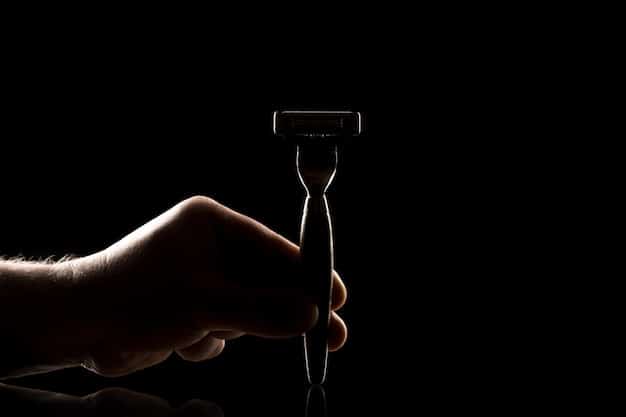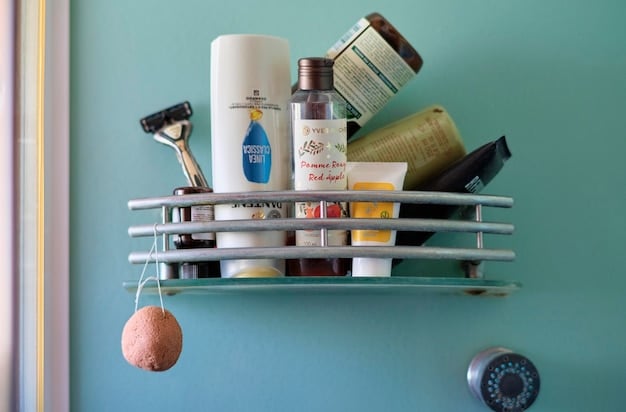Ingrown Hairs Be Gone: Expert Shaving Tips for Men – The Ultimate Guide

Ingrown Hairs Be Gone: Expert Shaving Tips for Men focuses on providing a comprehensive guide to help men prevent and treat ingrown hairs, ensuring a smoother, more comfortable shaving experience. This includes proper shaving techniques, skincare routines, and product recommendations.
Dealing with ingrown hairs can be a frustrating experience for any man. But what if you could say, Ingrown Hairs Be Gone: Expert Shaving Tips for Men are here? Imagine smoother skin and more confident shaves.
This guide is designed to provide you with the knowledge and techniques to achieve just that. Discover simple yet effective methods to prevent and treat those pesky bumps, so you can enjoy a fresh, clean shave without the irritation.
Ingrown Hairs Be Gone: Understanding the Basics
Before diving into the solutions, it’s essential to understand what causes ingrown hairs. This knowledge will help you tailor your shaving routine to minimize the risk of developing them.
What Are Ingrown Hairs?
Ingrown hairs occur when a hair that has been shaved or waxed curls back and grows into the skin. This often leads to inflammation, redness, and the formation of small, painful bumps.
Common Causes of Ingrown Hairs
Several factors can contribute to ingrown hairs, including:
- Improper shaving techniques
- Using dull razor blades
- Having curly or coarse hair
- Lack of exfoliation
Risk Factors
Certain individuals are more prone to developing ingrown hairs. These include:
- Men with curly or coarse hair
- Individuals with thick hair growth
- People who shave frequently
Understanding these basics provides a crucial foundation for implementing effective prevention and treatment strategies. It all begins with recognizing your own specific risk factors and tailoring your grooming routine accordingly. Now that you know what causes ingrown hairs, it’s time to learn how to prevent them from occurring in the first place.

Preparation Is Key: Setting the Stage for a Smooth Shave
Proper preparation is crucial for preventing ingrown hairs. Steps taken before shaving can significantly reduce the likelihood of developing these annoying bumps.
Cleansing Your Skin
Start by washing your face with a gentle cleanser to remove dirt, oil, and dead skin cells. This helps ensure a clean surface for shaving.
Exfoliating to Prevent Ingrown Hairs
Exfoliation is an essential step in preventing ingrown hairs. It removes dead skin cells that can trap hairs and cause them to grow inward.
Using a Warm Compress
Applying a warm compress to the area you plan to shave can soften the hair and open up the pores, making it easier to shave without irritation.
The Benefits of Pre-Shave Oil
Pre-shave oil can provide an extra layer of protection and lubrication. Choose natural oils like coconut or olive oil for the best results.
- Softens hair
- Provides lubrication
- Reduces friction
By including these preparation steps in your shaving routine, you’re setting the stage for a smoother, more comfortable shave. Proper preparation softens the hair, cleans the skin, and provides necessary lubrication, all of which help in the fight of Ingrown Hairs Be Gone: Expert Shaving Tips for Men.
Mastering the Shave: Techniques for Preventing Ingrown Hairs
The technique you use while shaving plays a significant role in preventing ingrown hairs. Adopting the right practices can greatly reduce the risk of irritation and bumps.
Shaving in the Right Direction
Always shave in the direction of hair growth. Shaving against the grain can cause the hair to curl back into the skin.
Using a Sharp, Clean Razor
A dull razor blade is a major culprit in causing ingrown hairs. Replace your razor blade regularly to ensure a clean cut.
- Reduces pulling
- Provides a cleaner cut
- Minimizes irritation
The Importance of Short Strokes
Use short, gentle strokes to minimize irritation. Avoid pressing down too hard on the razor.
Rinsing the Razor Frequently
Rinse the razor after each stroke to remove hair and shaving cream buildup. This keeps the blade clean and effective.
Mastering the shaving technique is another crucial component in achieving Ingrown Hairs Be Gone: Expert Shaving Tips for Men. By paying attention to the direction of hair growth, using a sharp razor, and employing gentle strokes, you can minimize the chance of ingrown hairs. Proper technique, in conjunction with proper preparation, can make a significant difference in your shaving experience.

Choosing the Right Products: Shaving Creams, Razors, and More
The products you use can have a big impact on your skin during and after shaving. Selecting the right shaving cream, razor, and aftershave can help prevent ingrown hairs.
Selecting the Right Shaving Cream or Gel
Choose a shaving cream or gel that is designed for sensitive skin. Look for products that are non-comedogenic and free of harsh chemicals.
Razor Types: Which Is Best?
Different razor types can affect your skin differently. Consider using a single-blade razor to minimize irritation.
Aftershave: Soothing and Protecting Your Skin
Aftershave can help soothe the skin and prevent infection. Look for products that contain moisturizing ingredients.
Specifically formulate aftershaves target irritation and the formulation of the pesky bumps that result from ingrown hairs. Aftershave can work as a great measure for Ingrown Hairs Be Gone: Expert Shaving Tips for Men!
- Reduces inflammation
- Moisturizes the skin
- Prevents infection
The choices you make regarding shaving products are essential for the final result. By choosing skincare-focused options such as creams and gels, protective aftershaves and the best razor for you, you’ll be setting your skin up for success. These products work together to guarantee that Ingrown Hairs Be Gone: Expert Shaving Tips for Men come to fruition.
Post-Shave Care: Nurturing Your Skin After Shaving
What you do after shaving is just as important as the shave itself. Proper post-shave care can help soothe the skin, prevent inflammation, and keep ingrown hairs at bay.
Applying a Cold Compress
After shaving, apply a cold compress to the area to reduce inflammation and close the pores.
Moisturizing Your Skin
Keep your skin moisturized to prevent dryness and irritation. Use a fragrance-free moisturizer to avoid further irritation.
Avoiding Tight Clothing
Tight clothing can rub against the skin and cause irritation, so wear loose clothing whenever possible.
Topical Treatments for Ingrown Hairs
Consider using topical treatments that contain ingredients like salicylic acid or glycolic acid to help exfoliate the skin and prevent ingrown hairs.
Post-shave care is a critical, often overlooked step in preventing ingrown hairs. By applying a cold compress, keeping your skin moisturized, and avoiding tight clothing, you can maintain healthy skin and minimize irritation from Ingrown Hairs Be Gone: Expert Shaving Tips for Men. Proper aftercare ensures that your skin remains smooth and comfortable, reducing the likelihood of those unwanted bumps.
Treating Existing Ingrown Hairs: Effective Remedies
If you already have ingrown hairs, don’t worry, there are several effective remedies. These treatments can help to alleviate irritation and promote healing.
Gentle Exfoliation
Gently exfoliate the area to help release the trapped hair. Use a soft brush or exfoliating scrub.
Using Tweezers
If the hair is close to the surface, you can gently lift it out with sanitized tweezers. Be careful not to pull the hair out completely, as this can worsen the problem.
Topical Treatments
Apply topical treatments containing salicylic acid or glycolic acid to help exfoliate the skin and reduce inflammation.
When to See a Dermatologist
If your ingrown hairs are severe or persistent, consider seeing a dermatologist. They can provide stronger treatments or recommend other solutions.
- Chronic irritation
- Severe inflammation
- Risk of infection
Treating existing ingrown hairs involves gentle care and effective remedies. Regular exfoliation can help release trapped hairs, while topical treatments reduce inflammation. Knowing when to seek professional help ensures that severe cases receive the necessary medical attention. With the right actions on Ingrown Hairs Be Gone: Expert Shaving Tips for Men, ingrown hairs don’t have to be painful or an issue for long. With these tips, you can easily and properly prevent and treat them.
| Key Point | Brief Description |
|---|---|
| 🧼 Skin Cleansing | Wash skin before shaving to remove dirt and oil. |
| 🪒 Proper Shaving | Shave in the direction of hair growth with a sharp blade. |
| 🧴 Post-Shave Care | Apply moisturizer and avoid tight clothing. |
| ✨ Gentle Exfoliation | Exfoliate regularly to prevent hairs from getting trapped. |
Frequently Asked Questions
Ingrown hairs occur when the hair curls back and grows into the skin, often due to shaving against the grain. Using dull blades and not exfoliating can also contribute to this problem.
To prevent ingrown hairs, always shave in the direction of hair growth, use a sharp razor, and exfoliate regularly. Also, apply a warm compress beforehand to soften the hair.
Yes, using shaving creams for sensitive skin, aftershaves with moisturizing ingredients, and topical treatments with salicylic or glycolic acid can help prevent and treat ingrown hairs.
If you have an ingrown hair, gently exfoliate the area and use sanitized tweezers to lift the hair if it’s close to the surface. Avoid pulling the hair out completely.
Consider seeing a dermatologist if your ingrown hairs are severe, persistent, or show signs of infection. They can provide stronger treatments and personalized advice to prevent future issues.
Conclusion
In conclusion, achieving Ingrown Hairs Be Gone: Expert Shaving Tips for Men can be attainable with the right knowledge and practices. By understanding the causes, mastering the shave, and nurturing your skin, you can enjoy a smoother skin.
Implement these expert tips into your routine for a confident, irritation-free shave every time. With proper preparation, shaving techniques, and aftercare, you can prevent ingrown hairs from occurring. With effective remedies, any existing ingrown hairs can be properly treated.





